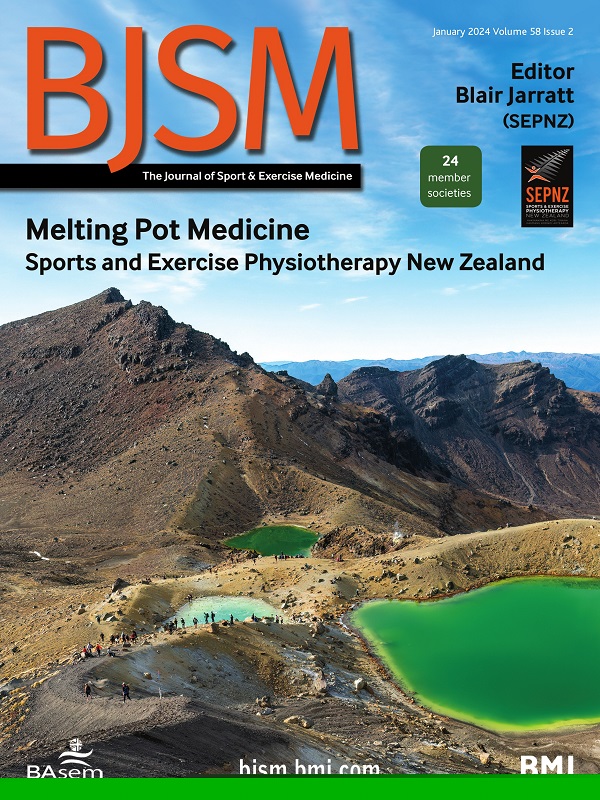心肺功能、体重指数与死亡率:系统回顾与荟萃分析
IF 11.6
1区 医学
Q1 SPORT SCIENCES
引用次数: 0
摘要
目的 本综述旨在评估心肺功能(CRF)和体重指数(BMI)对心血管疾病(CVD)和全因死亡率风险的共同影响。设计 进行了系统回顾和荟萃分析。采用带有稳健方差估计的三级限制性最大似然估计随机效应模型计算汇总 HR 和 95% CI。参照组为体重正常-体型合适,并与体重正常-体型不合适、超重-体型不合适和体型合适、肥胖-体型不合适和体型合适进行比较。数据来源 在 PROSPERO 上注册后,搜索电子数据库(PubMed/MEDLINE、Web of Science 和 SportDiscus)。资格标准 纳入符合以下标准的文章:(1) 发表于 1980 年 1 月至 2023 年 2 月;(2) 前瞻性队列研究;(3) 使用最大或 VO2 峰运动测试评估 CRF;(4) 报告并直接测量 BMI;(5) 分析 CRF 和 BMI 对全因死亡率或心血管疾病死亡率的共同影响;(6) 参照组为体重正常、体格健壮的人。结果 共有 20 篇文章被纳入分析,观察结果共计 398 716 个。与参照组相比,超重体质(心血管疾病 HR (95% CI):1.50 (0.82-2.76),全因 HR:0.96 (0.61-1.50))和肥胖体质(心血管疾病 HR (95% CI):1.62 (0.87-3.76),全因 HR:0.96 (0.61-1.50)1.62 (0.87-3.01), all-cause:1.11(0.88-1.40))的死亡风险没有统计学差异。正常体重-不适合(心血管疾病:2.04 (1.32-3.01)2.04 (1.32-3.14),全因:1.92 (1.43-2.40)1.92(1.43-2.57))、超重-不适合(心血管疾病:2.58(1.48-4.142.58 (1.48-4.52), all-cause:1.82 (1.47-2.24))和肥胖-不适合(心血管疾病:3.35 (1.17-9.52), 全因:1.92 (1.43-2.57))3.35 (1.17-9.61), all-cause:2.04(1.54-2.71))的死亡率风险高出 2-3 倍。结论 CRF 是心血管疾病和全因死亡率的有力预测指标,可降低与超重和肥胖相关的风险。这些数据对公共卫生和风险缓解策略具有重要意义。如有合理要求,可提供相关数据。本文章由计算机程序翻译,如有差异,请以英文原文为准。
Cardiorespiratory fitness, body mass index and mortality: a systematic review and meta-analysis
Objective The purpose of this review was to assess the joint relationship of cardiorespiratory fitness (CRF) and Body Mass Index (BMI) on both cardiovascular disease (CVD) and all-cause mortality risk. Design A systematic review and meta-analysis was conducted. Pooled HR and 95% CI were calculated using a three-level restricted maximum likelihood estimation random-effects model with robust variance estimation. The reference group was normal weight-fit and was compared with normal weight-unfit, overweight-unfit and fit, and obese-unfit and fit. Data sources Electronic databases (PubMed/MEDLINE, Web of Science and SportDiscus) were searched following registration on PROSPERO. Eligibility criteria Articles meeting the following criteria were included: (1) published between January 1980 and February 2023, (2) prospective cohort study, (3) CRF assessed using a maximal or VO2peak exercise test, (4) BMI reported and directly measured, (5) joint impact of CRF and BMI on all-cause mortality or CVD mortality were analysed, and (6) the reference group was normal weight, fit individuals. Results 20 articles were included in the analysis resulting in a total of 398 716 observations. Compared with the reference group, overweight-fit (CVD HR (95% CI): 1.50 (0.82–2.76), all-cause HR: 0.96 (0.61–1.50)) and obese-fit (CVD: 1.62 (0.87–3.01), all-cause: 1.11 (0.88–1.40)) did not have a statistically different risk of mortality. Normal weight-unfit (CVD: 2.04 (1.32–3.14), all-cause: 1.92 (1.43–2.57)), overweight-unfit (CVD: 2.58 (1.48–4.52), all-cause: 1.82 (1.47–2.24)) and obese-unfit (CVD: 3.35 (1.17–9.61), all-cause: 2.04 (1.54–2.71)) demonstrated 2–3-fold greater mortality risks. Conclusions CRF is a strong predictor of CVD and all-cause mortality and attenuates risks associated with overweight and obesity. These data have implications for public health and risk mitigation strategies. Data are available upon reasonable request.
求助全文
通过发布文献求助,成功后即可免费获取论文全文。
去求助
来源期刊
CiteScore
27.10
自引率
4.90%
发文量
217
审稿时长
3-8 weeks
期刊介绍:
The British Journal of Sports Medicine (BJSM) is a dynamic platform that presents groundbreaking research, thought-provoking reviews, and meaningful discussions on sport and exercise medicine. Our focus encompasses various clinically-relevant aspects such as physiotherapy, physical therapy, and rehabilitation. With an aim to foster innovation, education, and knowledge translation, we strive to bridge the gap between research and practical implementation in the field. Our multi-media approach, including web, print, video, and audio resources, along with our active presence on social media, connects a global community of healthcare professionals dedicated to treating active individuals.

 求助内容:
求助内容: 应助结果提醒方式:
应助结果提醒方式:


